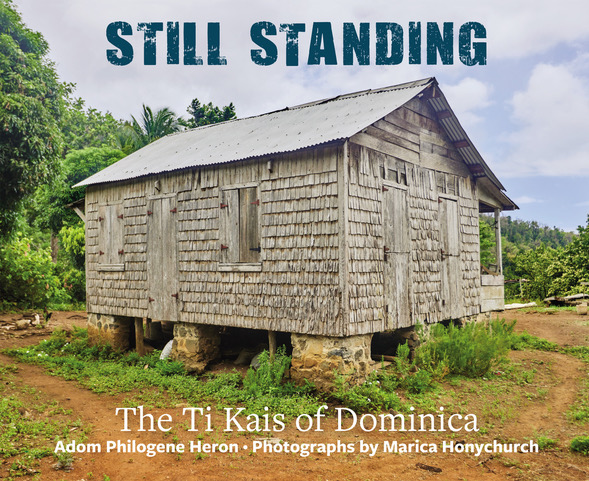
Still Standing, the story of the vanishing vernacular architecture of Dominica, is to be launched in Dominica on Monday (19 December) following its UK publication in October. Written by Adom Philogene Heron with photographs by Marica Honychurch, and a foreword by Lennox Honychurch, Still Standing looks at the history and importance of the ti kai to the heritage of this island. The beautifully illustrated book features interviews with those who live in Dominica’s few remaining ti kai and explores how and why they have survived for so long.
These small wooden houses, ingeniously crafted and carefully adapted to their environment, have survived hurricanes and earthquakes. In contrast to many modern concrete buildings, they are ‘still standing’. Even so, they are under threat.
The author, Adom Philogene Heron, who describes himself as a ‘grandchild of Colihaut’, is a British-born anthropologist at Goldsmith’s University of London.Still Standing represents a strand of his ongoing project,
Surviving Storms, which explores the past, present and future of Dominica’s relationship with hurricanes: ‘Learning how past communities survived and built houses with the hurricane in mind.’
Still Standing does not wish to paint the ti kai ‘as some quaint relic of an island’s past, but, as both living, ever evolving examples of creole heritage and as a model of “resilient” and sustainable dwelling.’ The stories and images in this book provide powerful evidence for vernacular conservation and, it is hoped, will thus inspire new respect for Dominica’s history and culture.
Adom Philogene Heron’s perceptive and illuminating introduction ends with a call to both respect and reclaim the ti kai: ‘Perhaps we need not look to distant shores or international experts for cutting edge models of “resilience”, when, in fact, the environmentally responsive and hurricane-secure ti kai presents us with a native form of human habitation that is so carefully attuned to its island home.’
Photographer Marica Honychurch was born and raised in Dominica; after moving to the US as a teenager she gained a BFA at the University of Colorado before returning home. She is a well-known freelance photographer and videographer and her work has appeared in international publications. She says that: “Having a little window into the lives of people living in Dominica’s unique structures was intriguing and allowed me to not only capture their pride in their homes but also gave me more insight into the strength of these fascinating buildings.”
The book will be available for sale in Dominica at Zeb Kweyol, Jays, K-Kai boutique, and the Douglas Charles airport. Still Standing is published by Papillote Press, based in Dominica and the UK.
What they say about this book:
‘Beautifully presented and engaging… Ti kais speak so subtly of the notion of home in a tropical climate.’ Jonathan Glancey, former architecture correspondent, The Guardian, UK
‘A must read for anyone interested in the architecture of the Caribbean or more generally the social anthropology of buildings.’ Louis P Nelson, professor of architectural history, University of Virginia
For further information, please contact the publisher, Polly Pattullo, on 295 1563.

Not ashamed to say I lived in one similar to this one. Used to play under the house with a little piece of stick digger the earth looking for “Tottie.” They use to come up on the surface and I would kill them. This was my Nintendo game. The best part was listening to the rain falling on the galvanized roof. I still have the photo of the shingled house I grew up in after I left the PMH two days after I was born. I’ve been here a pretty long time. The framing of our house didn’t have any nails; but wooden spikes. I could see my grandma now sitting there wondering what will become of her grandson. Well, granny have long been gone – but I miss her dearly and our shingled house. I still visit the site whenever I’m in town. I’m thankful for my humble beginning; and I’m still humble. Just don’t mess with me 😂😂
Hi, I’m Ros, from Australia. What is a tottie?
Lately I’ve been learning about the Dominican Republic, out of curiosity 😊. Beautiful place.
I don’t know what a “tottie” is either Rose :-)
I do know that this site is about “The Commonwealth of Dominica” though :-)
It’s a different place entirely to the Dominican Republic.
It’s an island between Martinique and Guadeloupe and my wife’s family hail from there.
It’s certainly worth learning about in its own right as well. :-)
Hope that’s helpful
There are those that are still standing after hurricanes David and Maria. They were constructed with the hurricanes in mind.
I think you should maybe explain what you mean by ‘surviving a hurricane’.
I grew up in one similar to this before coming to the UK aged 6, to meet my mother, who had travelled to England a few years before.
I can’t really comment on the structure, and not denigrating the house in anyway, as the one I lived in on Potters Street, Pottersville, was still standing up until 30 or so years ago (not entirely sure when it was knocked down), but my thoughts are that they were easy to rebuild (on the surviving pillars) after the passage of a hurricane, as I can’t imagine how a wooden structure such as this would withstand hurricane force winds.
The is also a well kept one in the village of Tetemorne